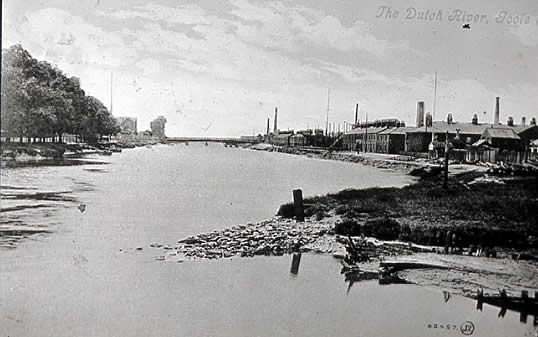A description of Goole, Yorkshire in 1810
A description of Goole on June 15th, 1810
This was written by Mrs Susannah Best [nee Storr] and is an account of the first visit she paid to Goole when she was about 12. She later lived with her husband Robert on a farm in Old Goole. As far as I can find, it is one of the first descriptions of Goole. She wrote this account when she was in her nineties:
...
'We set out for a journey from Selby to Blacktoft. It was no slight undertaking, for our only means of transit was either by horseback - and at midsummer the roads were scarcely passable - or by water. We chose the latter and started on Friday morning, full of delight at the unusual excitement of a journey. Our vessel was a small schooner named The Adventure, built expressively for the Leeds trade and therefore made to fit the lock on the way to that town. She was one of the first boats that ever made the journey from Leeds to London.
Wind and tide must have been against us, for it was Sunday morning
before we cast anchor at the mouth of the Dutch River [formerly
known as Willow Tree roads]. From this point you can have a view
of Goole as it was then.'

Dutch River, looking towards the Dutch River Bridge
'On the New Goole side your eye would have wandered hopelessly in search of anything to denote civilization; there was one old thatched house and ploughed fields.This house stood rather nearer the docks than the present Lowther hotel does and was eventually pulled down by Admiral Sotheron, who built the house now occupied by Mr George Duckels in its stead in 1822.
Those ploughed fields have strangely altered since then; a line
drawn diagonally from the wooden bridge [now pulled down] to [?]
will give a fairly correct outline of the boundaries of the farm
known as Moorfields. It all belonged at that time to Mr Thistleton
of Scarborough, who had to maintain in good order the whole of the
banks surrounding this tongue of land. He was therefore exempted
from the payment of highway; this land was afterwards sold for the
purpose of cutting the docks at the rate of £95 an acre. The
level of the land was much lower than at present. The part of Goole
now used for a recreation ground [now the Stanhope dock] is almost
the only portion remaining at the original level.
At the present day it is neither an easy nor a cleanly undertaking
to land at the mouth of the Dutch river, but then our means were
primitive, simply the backs of the boatmen. A narrow flagged footpath
on this muddy bank was all the pavement possessed. My recollections
suggest that every flag was broken and that every step produced
a squirt-like motion from the mud beneath, which was not pleasant,
but we had no Local Board in those days and the pavement was almost
as bad as it is now in Old Goole.
Two small public houses adorned the bank of the river, the Boat
Inn and the Anchor; the latter has long since disappeared. Crossing
the bridge another public house met our view named the Half Moon
[now pulled down], an old thatched cottage occupied by the Robinsons
and their three cottages under one roof afterwards known as Ivy
House, now replaced by Heber Terrace.
Here I would draw your attention to the old clough, neither altered
nor improved since those days. William Storr, steward for the commissioners
for the drainage of Hatfield Chase, was ordered to bring the Dempster
drain down so far as to make an outlet for it into the Dutch river;
this he did apparently to the satisfaction of all posterity for
no one has presumed to improve it since.
The corner house [also pulled down], though much dilapidated, was
the nearest approach to a 'good' house that we had yet come to,
and what would our children think of it now? Low and thatched, with
deep eaves and open chimneys, its internal arrangements were more
barn like than home like. I think a tenant would be difficult to
find for it nowadays.
Grove House was built about 1730, but it had no neighbours until
a few cottages on the left and Manor Cottage on the right were reared.
This house was slightly above the level of the road and a tongue
of the moors came within two fields of the back of it. Goole Hall
of that day was a picturesque old place with long lancet windows,
possibly more ornamental than useful. As late as the year 1818,
only twelve houses stood in the village or town and eight of these
were on Old Goole side of the river.'
